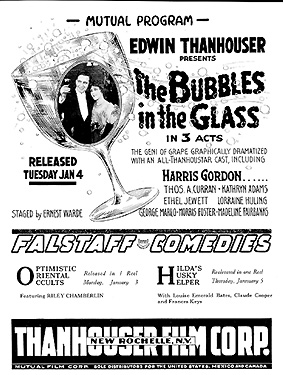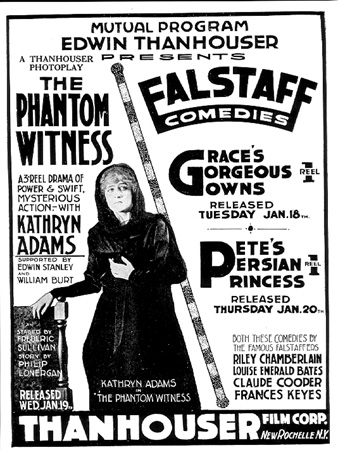 Volume I: Narrative History
Volume I: Narrative History Volume I: Narrative History
Volume I: Narrative History
The nature of the Thanhouser Film Corporation's releases on the Mutual program was revised in 1916. Gone were the one-reel dramas and other one-reel productions, except for Falstaff comedies. Two reelers became a rarity. Now, nearly all regular films were three reels or longer in length. Those of three reel length were called Than-O-Plays, but as months went on, the Than-O-Play designation was used less and less.
The January 1916 schedule commenced with a Falstaff comedy, The Optimistic Oriental Occults, as part of a program of one-reel comedies issued each Monday and Thursday until the 18th of the month, when the schedule was changed to Tuesday and Thursday. Other January entries for Falstaff included Hilda's Husky Helper, Belinda's Bridal Breakfast, Reforming Rubbering Rosie, Grace's Gorgeous Gowns, Pete's Persian Princess, Lucky Larry's Lady Love, and Beaten at the Bath. Note About the only trade journal to take note of these pictures was The Moving Picture World, which gave them generally favorable reviews.
The Bubbles in the Glass, a three-reel Than-O-Play released on January 4th, starred Harris Gordon as an alcoholic bent on suicide. "This picture will be welcomed by temperance workers," commented The Moving Picture World. Then followed In the Name of the Law, a Than-O-Play issued on the 11th, featuring Gladys Hulette as Daisy Rudyard, a girl of the mountains.

Advertisement for three January 1916 films: THE BUBBLES IN THE GLASS with Harris Gordon, Thomas A. Curran, Kathryn Adams, Ethel Jewett, Lorraine Huling, George Marlo,
Morris Foster and Madeline Fairbanks. Also: OPTIMISTIC ORIENTAL OCCULTS with Riley Chamberlin, and HILDA'S HUSKY HELPER with Louise Emerald Bates, Claude Cooper, and Frances Keyes (Reel Life)
The Woman in Politics, a five-reel Mutual Masterpicture, Deluxe Edition release on January 13th, featured a fire scene taken at an old factory building in Mamaroneck, New York, contiguous to New Rochelle. The Morning Telegraph reviewed the picture:
An exciting fire scene marks the climax of this political melodrama. The burning of a tenement house is realistically and vividly shown, with several stirring rescues and some thrilling narrow escapes. These views of the destruction of a firetrap are shown at length and give the picture a spectacular interest.
The woman in politics is Beatrice Barlow, a young doctor on the health commission of the city. Beatrice's activities interfere with the interests of the mayor and a group of politicians, and she is dismissed. She complains to the governor and brings some unanswerable charges against the mayor. The city officials decide that she must be discredited and set about trumping up evidence against her. The politicians make every attempt to do away with the girl, but they are frustrated at every turn by a mysterious young man who takes it upon himself to act as a guardian for the girl. Her unknown friend turns out to be the secretary of the governor, who substantiates her charges against the mayor when the case comes up before him. The story is filled with action, moves briskly and is realistically set. Mignon Anderson is pleasing in the leading role and others in the cast are good.
Variety gave the film a very detailed treatment:
A five-reel Thanhouser (Mutual Masterpicture). It is a melodrama, story written by Lester Note Lonergan, billed as an "original story," directed by W. Eugene Moore, with Mignon Anderson and George Marlo featured. Mr. Lonergan need not have been so heady about that "original" on the bills, and Mr. Lonergan might send a box of cigars to Mr. Moore, just as a token that he recognizes the director in this feature saved the scenario writer. And for Mr. Lonergan to go right down the credit line he might give some of the cigars to Mr. Marlo and send Miss Anderson a box of candy. They also helped to lift up this very, very mild tale that has only for its own recommendation a couple of twists out of the ordinary in the entire manuscript.
The first is when the story was based upon a female inspector of the Board of Health, and the next, when the same female came quite close to being trapped through the machinations of the mayor, who wanted to save himself in a trial he had to undergo before the governor. She was rescued by the intervention of the governor's secretary. The latter young man (Mr. Anderson) had been sent to investigate the inspector's complaint against the mayor, and overheard the plot to compromise her by the chief inspector of the health department hiding under the bed in her hotel room, No. 15. The secretary engaged No. 16, then changed the numbers, and afterward captured the chief inspector, making the same officers the mayor had brought with him to find the man in Room 15 arrest the "burglar."
This all came about through the female inspector having discovered smallpox at 234 Oak Street in some village that looked very much like Port Chester, N.Y. That is near New Rochelle, where are the studios of the Thanhouser and nearby these studios several of the other open air scenes were taken. It happened the chief inspector knew 234 Oak Street belonged to the mayor. He told the girl to withdraw her report on the place, and when she would not, he, acting under instructions from the mayor, fired her. She threatened to invoke the aid of the local daily, but an associate male inspector informed her the mayor had the local press gagged. This male inspector was well played, as to the work and in type, by an unnamed player. Contrast pictures showed him inspecting bottles behind a saloon bar while the female kept on the job. After this the girl wrote her complaint to the governor, and then the villain commenced to pursue her, and he did, right into a private sanitarium where she remained for a week. BUT our hero wasn't loafing. He saved her at a fire after she was fired and he saved her from the sanitarium and he brought her back on the governor's trial day and then the mayor got fired, right on the spot, which is another of the technical faulty details, but there has been a rather wide license anyway taken in this picture.
And where did Mr. Moore come in? He came in at the fire. There was a real reel fire, somewhat extended with Port Chester's limited force, though New Rochelle could have contributed a line of hose from its road houses which would have pleased any film audience. The fire was well done; even if too long and even if the firemen paid no attention to our governor's secretary hero when he ambled along, saw his lady hanging out of a window and climbed a ladder as though walking on eggs. Mr. Moore is also responsible for the general action, of which there is much, the human interest, well worked (though the house had to laugh at the expected appearance of the firesaver), and the building up sufficiently of an actual one-reel story Note into a satisfactory five-reeler.
The studio scenes, and there were many, had a peculiar light effect. The light was obtained from above. Only in one bare room was there a lamp, but that might not be noticed. Barring that Miss Anderson a couple of times grew too anguished, she did all right, and Mr. Marlo was certainly there as the secretary to the governor (nevertheless and notwithstanding the bills outside proclaimed he was a young doctor in the film). As a regular release with melodramatic tendency and that fire scene, The Woman in Politics is good enough for the once over, but the title suggests a broader scope and a stronger picture. - Sime.
The Phantom Witness, released as a Than-O-Play on January 19, 1916, fared somewhat better at the hands of a Variety reviewer:
Thanhouser has gone a step forward with The Phantom Witness, a three-reel Mutual release, scenario by Phil Lonergan, direction by Frederick Sullivan, and featuring Edwin Stanley, a newcomer in filmdom. The story is, briefly, a young district attorney is about to marry an orphaned heiress when her uncle, who has charge of her fortune, plots her death under circumstances which indicate suicide. Her demise sends the attorney into a long illness. Upon his return to court the girl's spirit appears to him and reveals the details of her murder. The attorney arranges to reopen the case and try an innocent man, knowing the guilty uncle will be at the trial.
During the case the uncle is called to the stand, and by hypnotic insistence the young man causes the uncle to see the spirit of his victim. The guilty man, unnerved, confesses and is led away. The attorney's pressure upon the guilty man, wherein he demands of him to "see as I do the spirit seated in that chair," is an excellent bit of intensity. At its conclusion the district attorney dies alone in the courtroom, but the spirit of his sweetheart appears to welcome him to the Great Beyond. Stanley, in the role of the attorney, gives promise of becoming a leading man of repute. He is handsome, well built, can act, and handles himself gracefully. The direction of the picture is good - exceptionally so, for a Thanhouser feature, but the photography poor. - Jolo.

Advertisement for several January 1916 films: THE PHANTOM WITNESS with Kathryn Adams, GRACE'S GORGEOUS GOWNS and PETE'S PERSIAN PRINCESS (Reel Life)
Copyright © 1995 Q. David Bowers. All Rights Reserved.